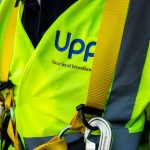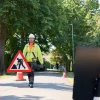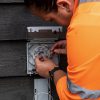BT Pilots New Form of Fibre-to-the-Basement Broadband in London
BT has today confused fibre optic connection terminologies a little by detailing their first pilot for a “new form” of Fibre-to-the-Basement / Building (FTTB) broadband technology in the City of London area, which uses VDSL2 over copper like FTTC but is optimised for basements / comms rooms where the operator has a wayleave/permission from the landlord and access to power.
Initially we thought this sounded a lot like the already known pilots of Fibre-to-the-Remote-Node (FTTrN) technology, which uses a similar approach and has also been confirmed for trials in the same area (here). But BT has since told ISPreview.co.uk that this is not the case because “FTTRN is a lot smaller and serves a smaller number of premises” (still sounds very similar though).
Advertisement
The “new” approach is being targeted towards the many areas in central London that still suffer from the dreaded Exchange Only Lines (EOLs), which is an issue that has been highlighted several times over the past year (here). EOLs are often long and slow pure copper lines that come directly from the exchange, which means they can’t easily be upgraded to support hybrid fibre systems, such as Openreach’s ‘up to’ 80Mbps capable FTTC, which pushes the fibre optic cable out to Street Cabinets and then distributes broadband over the remaining copper run using VDSL2 technology.
It is possible to build FTTC cabinets into an EOL area but various issues, such as the need for more extensive street works, access to a good power supply, finding the necessary development space and securing wayleaves for access to private land can all create significant complications. One solution to this is FTTrN, which does away with a street cabinet and instead takes the fibre optic cable all the way to a much smaller remote node (think of it as a tiny street cabinet) that can be positioned on telegraph poles or underground.
However BT’s “new” FTTB approach, which isn’t traditional FTTB because it uses VDSL2 over the remaining copper wire instead of a more direct Ethernet solution, is designed to tackle a larger area. The trial itself will involve 225 homes in the Middlesex Street Estate and around 50 SMEs based at 65 London Wall will have access to download speeds of up to 80Mbps for the first time.
Joe Garner, CEO, Openreach said:
“We’re constantly exploring new ways to deliver fibre broadband to residential customers into city-centres, so we are excited to announce the launch of this trial.
City-centre locations present unique challenges when it comes to upgrading consumer broadband. For example, there is less room for us to install a fibre cabinet on the pavement, and it is often harder to get permission to close roads to do the work. We also need to secure permission from multiple landlords to run new cables across their land and properties.
That’s why we are being innovative with new technology solutions like this one. We optimistic that this new solution will prove that fibre broadband can be installed into building basements quickly, smoothly and economically. It could also have the added benefit of being less disruptive for our customers and the general public.”
Graham Bell, Chief Information Officer of the City of London Corporation, said:
“All businesses are keener than ever to be well-connected and this ‘Fibre-to-Basement’ pilot is a welcome step forwards, especially for smaller SMEs, who are critical to London’s commercial dynamism. We hope the trials will lead to further expansion of fibre broadband across the Square Mile for residents and SMEs, complementing the Ethernet infrastructure already available to larger firms.”
The press release doesn’t give a lot of additional detail, although it’s clearly designed as a response to concerns raised by the City of London Corporation and other local businesses. Many of those suffer from EOLs and this has been holding connectivity in the area back.
Advertisement
We suspect that those who benefit from the “new” FTTB approach can probably expect to receive closer to the top service speed than a traditional FTTC deployment would deliver. It’s also likely that BT picked VDSL2 instead of direct Ethernet for the last few metres so as to ensure compatibility with FTTC style packages in the existing market, which is important when you also need to cater for homes.
Mark is a professional technology writer, IT consultant and computer engineer from Dorset (England), he also founded ISPreview in 1999 and enjoys analysing the latest telecoms and broadband developments. Find me on X (Twitter), Mastodon, Facebook, BlueSky, Threads.net and Linkedin.
« Dorset UK Scraps Costly Kcom Built Fibre Optic Public Sector Network

















































Comments are closed